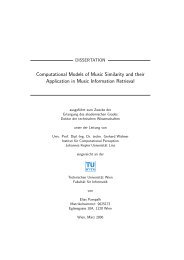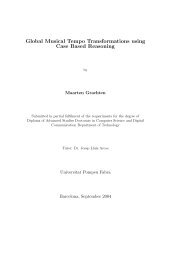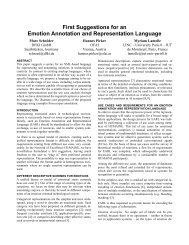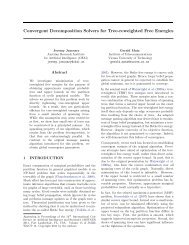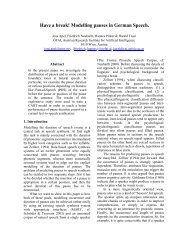A HYBRID MODEL OF REASONING BY ANALOGY
A HYBRID MODEL OF REASONING BY ANALOGY
A HYBRID MODEL OF REASONING BY ANALOGY
Create successful ePaper yourself
Turn your PDF publications into a flip-book with our unique Google optimized e-Paper software.
These experiments reveal the variable context-dependent behavior of the simulation system.<br />
7. COMPARISON TO RELATED WORK<br />
The current work has a lot of precursors and sources of ideas. I will try to mention at least some of<br />
them. Related architectures will be reviewed initially and then - some related models of analogical<br />
reasoning.<br />
7.1. Hybrid Architectures<br />
In the recent years interest in hybrid architectures has emerged and grown (Hendler, 1989,<br />
Barnden & Pollack, 1991, Stark, 1991). Several examples taken from contemporary research will<br />
be considered below.<br />
One of the well-known proponents of this approach is Hendler. He regards marker passing and<br />
connectionism as two different types of spreading activation (spreading symbols and numbers<br />
respectively), proposing a hybrid planning system which combines both of them (1989a, 1991).<br />
Actually, his system consists of two separate modules which interact with each other. The first<br />
module is a semantic network with a marker passing mechanism running over it and the second<br />
one is a connectionist network with numeric activation spreading over it. These two networks have<br />
common nodes which are used for interaction between the modules: when such a node is being<br />
marked, then it becomes a source of activation for the connectionist network, and vice versa -<br />
when activated, it starts to spread a symbolic marker. In this way only one type of markers can be<br />
used in the semantic network.<br />
In contrast to the above mentioned architecture and according to my understanding of dualism and<br />
consistent hybrid approaches (see section 1.2), marker passing and spreading of numeric activation<br />
are considered just as two dimensions of a single network (the reasoner's LTM) in the architecture<br />
presented in this chapter. In this way a single node has always an associated activation level and<br />
can hold a number of different markers. This makes it possible to establish simultaneously the<br />
semantic correspondences needed by the mapping process and even to run several marker passing<br />
processes in parallel.<br />
In order to limit the number of marked nodes a kind of attenuation mechanism is used in Hendler's<br />
architecture. It involves an "energy" numeric value (called zorch) associated with each symbolic<br />
marker, which is then divided by each node's outbranching as marking proceeds. In this way both<br />
the length and the outbranch of the paths found are limited. In my view, this approach has two<br />
shortcomings. First, it seems redundant to use two different numeric activations (zorch and<br />
connectionist activation) even in a hybrid architecture when a single one would do the job. Second,<br />
this criterion for path preference is too rigid and not well grounded psychologically. In contrast, a<br />
context-dependent path preference criterion is used in our architecture using a single activation<br />
value (so it is also possible for a long and highly outbranching path to be preferred in a very<br />
specific context).<br />
Another hybrid approach involving both marker passing and spreading activation has been<br />
proposed by Lange and Dyer (1989), Lange, Melz, Wharton, and Holyoak (1990), Dyer (1991).<br />
They, too, like Hendler, use two different networks - one for markers (the so called top plane) and<br />
another for spreading activation (the bottom plane), but they consider both networks as parallel,<br />
i.e. with definite correspondences between their nodes and links. The nodes in the bottom plane<br />
represent frames (concepts) and the links - the semantic relations between them. The nodes on the<br />
top plane correspond to the concepts' markers (identifiers) or to binding nodes for the frames'<br />
roles and the links connect binding nodes that have to be bound by the same markers. A marked




